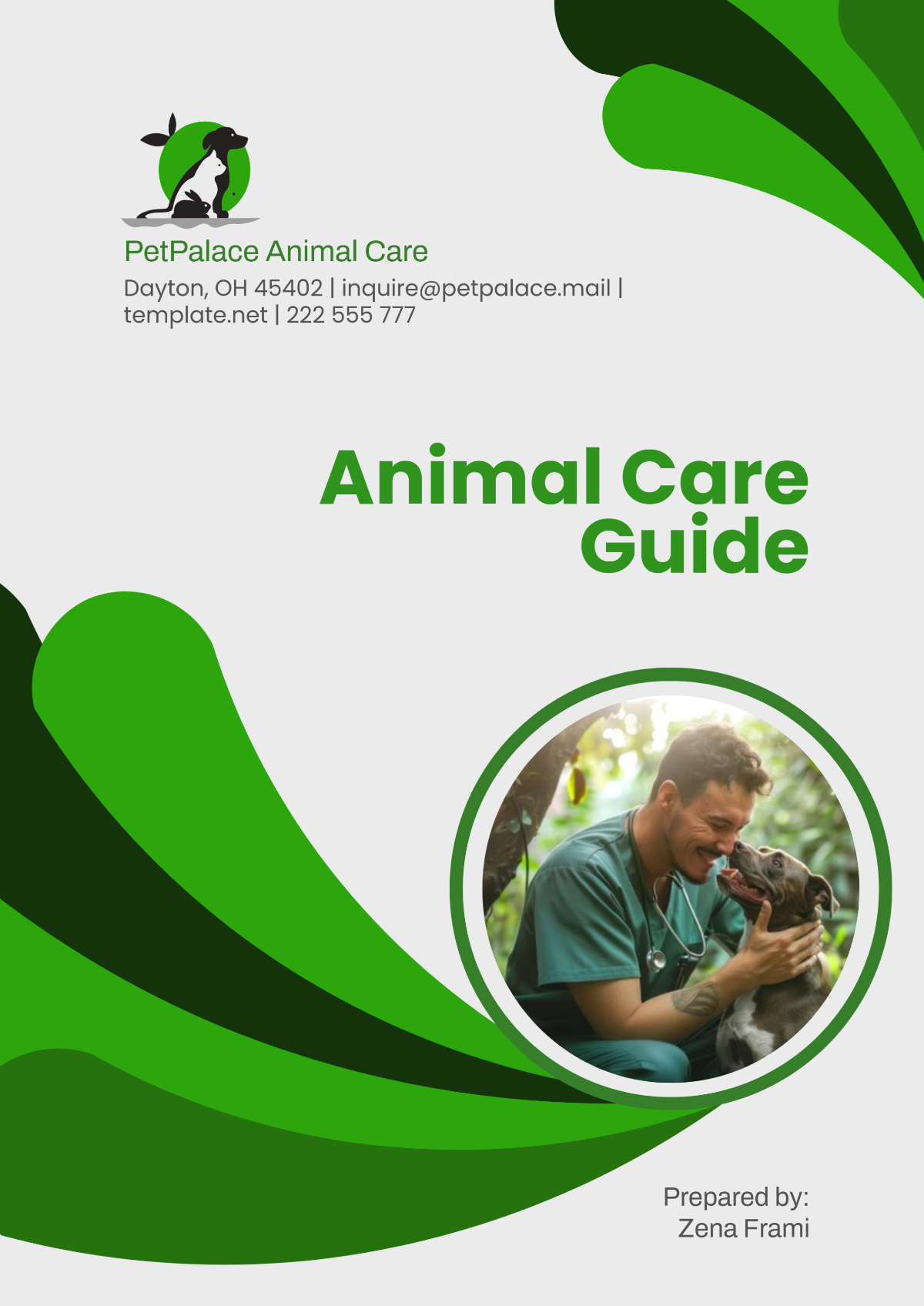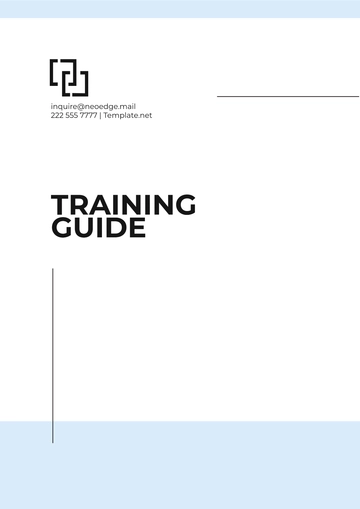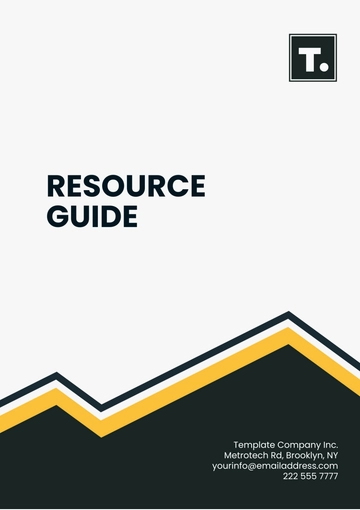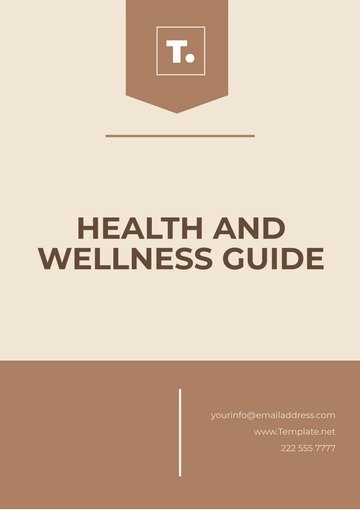Free Animal Care Guide

This comprehensive Animal Care Guide has been created by [Your Company Name] to help caregivers maintain the well-being of animals under their care. The guide provides a detailed, practical approach to managing the various needs of pets, livestock, and wildlife, covering essential aspects of daily care, health, diet, environment, and emergency protocols. As the field of animal care evolves, [Your Company Name] remains committed to ensuring that caretakers have the knowledge and tools necessary to provide the best possible care for all animals. This guide will help caregivers create environments that promote animal well-being, happiness, and health.
I. Introduction to Animal Care
Animal care is an integral part of animal husbandry, veterinary care, and personal responsibility for animal owners. It is a field that requires both scientific knowledge and emotional understanding, as each species has different physical, nutritional, and emotional requirements. Whether caring for pets, livestock, or wildlife, caregivers must consider every aspect of an animal's well-being to ensure they live a long and healthy life. A comprehensive understanding of animal needs allows caregivers to tailor their approach to the individual animal’s specific requirements.
A. Purpose of Animal Care
Ensuring Safety and Well-being
The primary goal of animal care is to ensure that the animals are safe, healthy, and living in a stress-free environment. This includes providing for their basic needs, preventing disease, and monitoring for any changes in behavior or health. The well-being of an animal depends on the caregiver's ability to recognize and address both obvious and subtle signs of distress or discomfort.Reducing Animal Suffering
Responsible care reduces the risk of injury, disease, and distress, preventing animals from suffering unnecessarily. Timely interventions, such as administering medication or seeking veterinary advice, can alleviate pain and extend an animal’s quality of life. Regular health checks help identify potential health issues before they become serious.Fostering Positive Human-Animal Relationships
In addition to physical care, animal care includes building a strong emotional bond between the caregiver and the animal. Positive human-animal interactions strengthen trust and foster cooperation, benefiting both the animal and the human. For pets, this bond can enhance the animal's quality of life and ensure a peaceful and loving environment.
II. Understanding Animal Needs
Each species has unique needs that must be met for them to live healthy, happy lives. Understanding these needs is essential for ensuring the well-being of an animal, as neglecting or mismanaging any aspect can result in behavioral problems, illness, or premature death.
A. Physical Needs
Shelter
Animals require shelter that provides protection from the elements and environmental dangers such as predators or extreme weather. A well-constructed shelter helps maintain a comfortable temperature, reduces stress, and prevents health issues. The size of the shelter should correspond to the size and number of animals being housed to ensure adequate space for movement and comfort. For example, dogs require enough room to stretch out, while rabbits need hideaways where they can feel safe and secure.Food and Water
Animals must be provided with fresh, clean water and a balanced diet that meets their specific nutritional needs. Proper hydration is just as important as the right nutrients. Malnutrition or dehydration can lead to serious health problems, including organ failure and immune system suppression. It’s important to feed animals according to their size, age, and health needs. For instance, kittens and puppies require higher amounts of protein and calories, while senior animals may need diets with fewer calories but enriched with vitamins and minerals to aid in aging joints and bones.Exercise and Space
Just like humans, animals need physical activity to stay healthy. Exercise helps prevent obesity, maintains muscle tone, and keeps the cardiovascular system functioning well. In addition to exercise, animals also need sufficient space to move freely and engage in natural behaviors. For example, a dog should have space to run, play, and explore, while a cat requires climbing structures and places to hide. Livestock such as cows, goats, and sheep need pastureland for grazing and roaming to maintain proper digestion and prevent boredom.
B. Emotional and Social Needs
Socialization
Social animals, such as dogs, horses, and parrots, need regular interaction with humans or other animals to feel secure and emotionally fulfilled. Lack of socialization can lead to behavioral issues such as aggression, anxiety, or depression. It’s important to provide appropriate social engagement for animals to prevent loneliness and stress. On the other hand, solitary animals, such as many species of reptiles, may require limited social interaction but still benefit from mental stimulation and care.Mental Stimulation
Mental stimulation is as important as physical care in maintaining an animal’s health. Engaging animals in activities that challenge their minds can prevent boredom and reduce stress-related behaviors. Dogs and cats enjoy puzzle toys that dispense treats, while birds benefit from learning new tricks or interacting with other animals. Many animals require environmental enrichment to replicate the complexities of their natural habitats. For example, zoo animals are often provided with logs, branches, and water features that mirror their natural environment.Positive Reinforcement
Positive reinforcement is a highly effective training method that encourages desirable behaviors by rewarding them. For example, rewarding a dog with a treat when it sits on command strengthens the behavior and fosters a trusting bond between the caregiver and the animal. Training through positive reinforcement helps animals feel secure and understand expectations while simultaneously enhancing their mental health.
III. Animal Health and Hygiene
The health of an animal is paramount to its overall well-being. Proper care includes regular health check-ups, maintaining hygiene, and addressing any health concerns that arise.
A. Regular Health Check-ups
Vaccination
Vaccinations are a critical part of preventative healthcare. Routine vaccinations prevent many common and life-threatening diseases. For example, dogs should receive vaccines for rabies, distemper, and parvovirus, while cats should be vaccinated against feline leukemia and feline distemper. Livestock may also require vaccines to prevent diseases that could potentially affect humans or other animals. Regular vaccinations protect not only the individual animal but also the community from the spread of contagious diseases.Parasite Control
Fleas, ticks, mites, and worms are common parasites that can significantly affect an animal’s health. Regular treatments, such as deworming and flea prevention, help keep these pests at bay. External parasites like ticks can transmit diseases such as Lyme disease, while internal parasites like roundworms can lead to malnutrition and organ damage. A veterinarian should be consulted for the appropriate schedule and products for parasite control.Dental Care
Dental disease is common in pets, particularly dogs and cats, and can lead to severe problems, including tooth loss, gum disease, and even systemic infections. Regular brushing of teeth, dental chews, and professional cleanings help maintain good oral health. Early detection of dental issues, such as bad breath or gum redness, can prevent more serious complications in the future.Weight Management
Maintaining an animal’s ideal body weight is crucial to its overall health. Obesity is linked to numerous health problems, including heart disease, diabetes, arthritis, and decreased life expectancy. Portion control, appropriate food choices, and regular exercise can help prevent weight gain. Monitoring an animal’s weight and adjusting its diet and activity level as needed can help prevent obesity.
B. Hygiene Practices
Grooming
Grooming is essential to maintaining an animal’s skin and coat health. Depending on the species and breed, animals may require regular brushing, bathing, and nail trimming. For example, long-haired dogs and cats need regular brushing to prevent matting and reduce shedding. Horses and livestock often need grooming to remove dirt and debris, as well as to prevent hoof problems. Regular grooming is also an opportunity for caregivers to check for skin infections, parasites, or other health issues.Cleanliness of Living Spaces
Animals’ living environments should be cleaned regularly to maintain hygiene. This is especially important for indoor pets, as unclean living spaces can lead to respiratory issues, bacterial infections, and unpleasant odors. For dogs and cats, bedding should be washed frequently, and litter boxes should be cleaned daily. For livestock, manure should be removed regularly to prevent the buildup of harmful bacteria and pests.Waste Management
Proper disposal of animal waste is vital for health and hygiene. Animal waste can carry pathogens and parasites that can spread disease if not handled appropriately. For indoor pets, waste should be promptly disposed of, and litter should be replaced frequently. For larger animals, like horses or livestock, waste can be composted for environmental sustainability or removed by waste management services to maintain a clean and healthy environment.
IV. Animal Diet and Nutrition
Proper nutrition is fundamental to an animal’s health. Animals require a balanced diet to support their growth, energy, and overall well-being. A proper diet includes the correct balance of protein, fat, carbohydrates, vitamins, and minerals.
A. Nutritional Requirements
Balanced Diet
A balanced diet is critical to an animal’s growth and development. This involves providing the right proportions of proteins, fats, carbohydrates, vitamins, and minerals. Dogs, for example, need high-quality proteins to maintain muscle mass and fats for energy. Cats, being obligate carnivores, require a diet rich in animal protein and fat. Nutritional needs vary greatly between species and should be considered when choosing food for any animal.Dietary Supplements
Supplements may be necessary to support the health of certain animals. Senior dogs, for example, may benefit from glucosamine supplements for joint health, while fish oil can improve coat quality. If an animal has a specific health condition, such as kidney disease, dietary changes and supplements may be required to manage the condition. Always consult a veterinarian before introducing supplements to ensure the correct dosage and prevent over-supplementation.Age-Appropriate Diets
As animals age, their nutritional requirements change. Young animals, such as puppies and kittens, need nutrient-dense food to support rapid growth. Adult animals typically need a maintenance diet with moderate amounts of protein and fat. Senior animals may require specialized diets with lower calorie content and added supplements to address aging issues like arthritis or cognitive decline. A veterinarian can help determine the appropriate diet for animals at each life stage.Feeding Frequency
The frequency of feeding varies between species and individual animals. Some animals, like dogs, may eat two to three meals per day, while others, such as cats, may prefer several small meals throughout the day. Monitoring an animal’s appetite and adjusting feeding schedules is crucial to ensure they are receiving adequate nutrition.
V. Creating a Safe and Stimulating Environment
Animals require environments that are safe, secure, and stimulating. Providing an enriching environment supports both the physical and mental health of an animal, leading to better overall well-being.
A. Safe Housing Design
Space Requirements
Animals need space to move around freely, express natural behaviors, and rest comfortably. The type of enclosure will depend on the species of animal and the amount of space needed. For example, rabbits need a secure hutch, while large dogs may require a yard with a fence for safety. Overcrowding in a living space can cause stress and lead to territorial behaviors or aggression.Temperature Control
Many animals are sensitive to temperature extremes. It is crucial to maintain an environment that keeps animals comfortable. For example, dogs and cats should be kept indoors at comfortable temperatures, while reptiles may need a heated terrarium to mimic their natural habitat. Livestock animals, such as cattle and sheep, require shelter from harsh weather conditions to prevent heat stress or frostbite.Environmental Enrichment
Environmental enrichment includes the addition of toys, climbing structures, hiding spaces, and other stimuli to promote mental and physical activity. Pets like cats, dogs, and birds benefit from items that allow them to engage in natural behaviors like hunting, climbing, and scratching. Enrichment helps prevent boredom and encourages exploration, play, and exercise.
VI. Emergency Animal Care
Animals may encounter health emergencies at any time, and a caregiver must be prepared to respond quickly and effectively to mitigate harm. Understanding how to address common medical emergencies can save an animal’s life.
A. Recognizing Medical Emergencies
Signs of Distress
Animals often show signs of distress or illness through changes in behavior, eating habits, or physical appearance. Common signs that may indicate a medical emergency include:Rapid or labored breathing
Excessive drooling or foaming at the mouth
Vomiting, diarrhea, or sudden lethargy
Seizures or uncoordinated movements
Pale gums or difficulty breathing
Excessive bleeding or open wounds
If any of these signs appear, immediate attention is necessary.
Types of Common Emergencies
A range of emergency situations can arise depending on the species and environment of the animal. Some of the most common emergencies include:Trauma: Injuries from accidents or fights, such as broken bones, wounds, or burns, require urgent care to prevent further complications.
Poisoning: Ingestion of toxic substances (e.g., household chemicals, plants, or certain foods) can cause severe reactions. Symptoms may include drooling, vomiting, convulsions, or diarrhea.
Heatstroke: This is common in hot climates or after strenuous activity, particularly in animals with short noses (like bulldogs) or thick coats. Symptoms include excessive panting, drooling, and collapse.
Bloat: Particularly dangerous in deep-chested dog breeds, bloat can cause the stomach to twist and expand rapidly, leading to shock and death within hours. Symptoms include abdominal swelling and discomfort.
Choking: Ingesting foreign objects or food items that block the airway is a life-threatening emergency, often resulting in coughing, pawing at the mouth, and difficulty breathing.
First Aid Procedures
Knowing the basic principles of first aid can make the difference between life and death. Here are a few general procedures:CPR (Cardiopulmonary Resuscitation): In cases where an animal has stopped breathing, or its heart has stopped beating, CPR can revive them until professional help arrives. Perform mouth-to-nose resuscitation and chest compressions if necessary.
Controlling Bleeding: Apply pressure to the wound using a clean cloth or bandage to stop bleeding. If the wound is severe and arterial, elevate the injured limb and apply pressure above the wound to restrict blood flow.
Poison Control: If poisoning is suspected, immediately contact a veterinarian or animal poison control hotline for guidance. Inducing vomiting may be necessary, but it must be done under professional advice to avoid additional harm.
When to Seek Veterinary Help
While first aid can manage many situations, any severe emergency must be followed up with professional care. A veterinarian should assess the animal for proper diagnosis and treatment, particularly in cases of trauma, poisoning, or prolonged distress.
VII. Specialized Animal Care
In some cases, animals require specialized care due to unique physical, behavioral, or medical needs. This may involve treating chronic conditions, working with high-maintenance breeds, or providing specific training or therapeutic interventions.
A. Caring for Senior Animals
Age-Related Conditions
As animals age, they may develop a variety of health issues, including arthritis, vision and hearing loss, cognitive decline, and more. Senior animals may need extra assistance with mobility, such as ramps or padded bedding. They may also require special diets to address changing metabolism and the need for additional nutrients.Preventative Measures for Seniors
Preventative care for senior animals should focus on regular health screenings, such as blood tests, dental exams, and joint health assessments. Keeping a senior animal active, through light exercise, as well as maintaining a balanced diet, can significantly improve their quality of life and longevity.Pain Management
Senior animals, especially those with arthritis or joint problems, may suffer from chronic pain. Veterinary guidance on pain management, including medication and supplements like glucosamine, can help alleviate discomfort and support mobility. In some cases, physical therapy and acupuncture may be beneficial treatments.
B. Caring for Pregnant Animals
Prenatal Care
For pregnant animals, ensuring proper prenatal care is critical. This includes a balanced diet rich in essential nutrients, keeping the animal’s environment calm and stress-free, and providing extra monitoring. Veterinary check-ups can ensure that the pregnancy is progressing well, and the mother is healthy.Preparing for Birth
The birth of a litter requires careful planning. Make sure the animal has a quiet, clean, and comfortable space to give birth. Ensure that the area is free of hazards, and monitor the animal closely for signs of labor. Immediate veterinary assistance may be required if complications arise, such as prolonged labor or signs of distress in the mother or newborns.Caring for Newborns
Newborn animals, such as puppies or kittens, need constant care and attention. They should be kept warm and fed appropriately, either through their mother’s milk or, in some cases, through formula if the mother is unavailable. Newborns are vulnerable to illness and dehydration, so it is essential to monitor them carefully for signs of distress or health issues.
C. Caring for Exotic and Uncommon Pets
Unique Needs of Exotic Pets
Exotic pets, such as reptiles, birds, and small mammals, often have specialized care needs. For example, reptiles require specific temperature and humidity levels, while birds may need spacious cages and social interaction. Research into the species-specific requirements of exotic animals is crucial before obtaining them as pets.Veterinary Care for Exotics
Exotic pets should see a veterinarian who is specialized in their care. Regular check-ups are important, especially to monitor for species-specific health concerns. For example, reptiles may develop metabolic bone disease if they lack sufficient UVB lighting, while exotic birds may experience feather plucking or respiratory issues.
VIII. Conclusion
Animal care is an evolving field that requires knowledge, compassion, and attention to the unique needs of each species. As we have seen throughout this guide, providing the best care for animals involves understanding their physical, emotional, and social needs, ensuring their health through proper nutrition and hygiene, and responding to emergencies with speed and care. Whether you’re caring for a pet, a farm animal, or an exotic species, the responsibility of ensuring their well-being should be taken seriously and with dedication.
At [Your Company Name], we are committed to supporting animal caregivers with the latest information and resources to help animals thrive in every environment. If you have any further questions or need personalized assistance, please reach out to [Your Company Name] at [Your Company Email] or visit our website at [Your Company Website].
Animal Care Templates @ Template.net
- 100% Customizable, free editor
- Access 1 Million+ Templates, photo’s & graphics
- Download or share as a template
- Click and replace photos, graphics, text, backgrounds
- Resize, crop, AI write & more
- Access advanced editor
Provide helpful pet care tips with the Animal Care Guide Template from Template.net. This editable and customizable template allows you to share essential care information with pet owners. Customize it using our Ai Editor Tool to create a thorough, tailored guide for each animal.





























